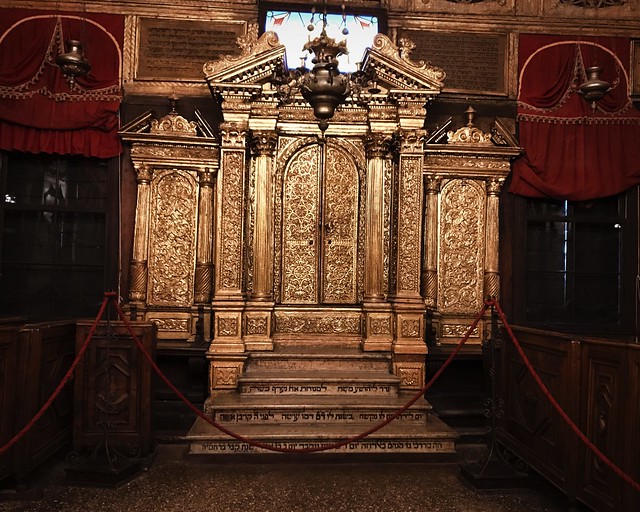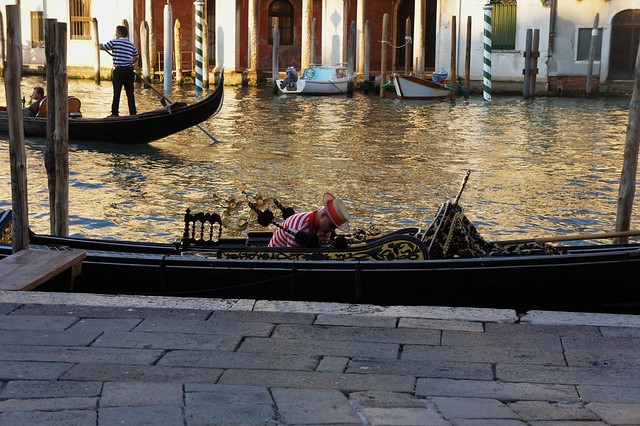The “Floating City” of Venice is famously made up of dozens of small islands crisscrossed by picturesque canals, but these islands are part of a larger patchwork of historic neighborhoods, or “sestieri”, each with a distinct character, charming “campo” square, and treasured, yet often little-known, church or monument. Luckily, aside from the outlying islands, most of Venice is conveniently compact, and its easy to strike out beyond the over-crowded A-list areas and explore the quieter and more pleasant backstreets—or back “calle”, in La Serenissima.

(Photo by CIUTravel via Flickr)
There are six sestieri on Venice’s main islands (or seven, depending upon how you count), though the lion’s share of visitors only take the time to see one or two. After taking in the Doge’s Palace and the Rialto bridge, stroll a bit further afield in almost any direction and you can discover a completely different side of Venice, a world away from the teeming crowds and questionable souvenir shops concentrated around Piazza San Marco.

(Photo by CIUTravel via Flickr)
Here is an overview of Venice’s main historic neighborhoods:
Star Power: San Marco
This is the sestiere seen by virtually every tourist that sets foot in Venice, as it’s home to St. Mark’s Square—known as Europe’s “drawing room”—lined by St. Mark’s Basilica and the Doge’s Palace and the Rialto Bridge. Bordered on three sides by the Grand Canal, it’s also where many of the city’s most iconic Grand Hotels are located, including one of our favorites: the Londra Palace. Though it’s de rigueur to follow in the footsteps of illustrious visitors like Lord Byron, Charles Dickens, Ernest Hemingway and settle in at one of the many outdoor cafés, we suggest you head to bordering Castello for a quieter repast or here for the best Bellini in town.

(Photo by CIUTravel via Flickr)
In the shadow: Castello
The Castello sestiere—the largest in Venice and the only that is not along the Grand Canal—borders on San Marco, but this quieter, more residential area is overshadowed by the glamour of its famous neighbor…which is its main draw. While the day-trippers and cruise-shippers swarm Piazza San Marco, you can stroll the charming Via Giuseppe Garibaldi promenade and lush Giardini della Biennale in peace. If you’re in the mood for a museum, near the historic Arsenale—where assembly lines once cranked out a Venetian warship in just hours—the Venice Naval History Museum and, every two years, La Biennale di Venezia contemporary art exhibition are worth a visit. Be sure to stop on the unassuming Arco del Paradiso bridge for one of the best views in the city.

(Photo by CIUTravel via Flickr)
The Ghetto: Cannaregio
Cannaregio, a large sestiere that stretches along the Grand Canal from the Santa Lucia train station to the *Rialto Bridge,* is one of the prettiest areas in Venice. Though it can be crowded along the Grand Canal, the tiny calli, campi, and canali in the center of the neighborhood are anchantingly quiet. Most visitors are drawn here by the historic Jewish Ghetto on Campo di Ghetto Nuovo, but you can also wander and dine on the area’s canal-side fondamente, lined with shops, restaurants, and bàcari wine bars serving traditional cicchetti. Just because it has a laid-back vibe doesn’t mean Cannaregio doesn’t hold its own artistic treasures: the Ca’ D’Oro is considered one of the most beautiful palazzi along the Grand Canal, the Madonna d’Orto church holds a trove of Venetian Gothic masterpieces, and Santa Maria dei Miracoli is a 15th-century marble wonder.

(Photo by CIUTravel via Flickr)
Gourmet Delights: San Polo
Just across the Rialto Bridge from San Marco, Sestiere San Polo is one of the oldest areas of Venice and home to the city’s open-air market, which can be quite crowded (more with tourists snapping photos than locals shopping). Some of the best gourmet shops and informal restaurants in the center are tucked in its internal warren of lanes, and at night this is a great place to stop for cicchetti. The smallest neighborhood in Venice, San Polo has a distinctly medieval feel despite the grandeur of Tintoretto’s masterpieces in the Scuola Grande di San Rocco and those of Titian in the Frari Church.

(Photo by CIUTravel via Flickr)
Artistic Masterpieces: Dorsoduro
Dorsoduro is a large sestiere that also sits across the Grand Canal from San Marco, and is a unique mix of trendy bars and cafés filled with Venice’s university students and some of the most important churches and museums in the city. Take the Ponte dell’Accademia across to visit the Accademia Museum and the Peggy Guggenheim Collection, two of Venice’s top art collections. Tour the Baroque Ca’ Rezzonico to get a glimpse of the sumptuous lifestyle of Venice’s wealthiest families in the 16th century. Pop into the soaring 17th-century Basilica di Santa Maria della Salute and the modest San Sebastiano, covered from floor to ceiling with paintings by Veronese. End your day with a sunset stroll down the Fondamenta delle Zattere along the Giudecca Canal, gelato in hand.

(Photo by CIUTravel via Flickr)
Palazzo Museums: Santa Croce
Like bordering San Polo, Sestiere Santa Croce is one of the oldest areas in Venice, and is also among the least visited. Parts of the university are located here, and there is a mix of fine dining restaurants and casual pizzerias. Locals gather around the quiet Campo San Giacomo dell’Orio, with its 10th-century church, and along the Grand Canal you can visit the ornate Ca’ Pesaro, a Baroque palace housing Venice’s Museum of Modern Art, and San Stae, known for its unique façade featuring Corinthian details. One of the most interesting museums in Venice is just behind San Stae, the Palazzo Mocenigo Museum of the History of Textiles and Costumes, with a special section dedicated to perfume.

(Photo by CIUTravel via Flickr)


